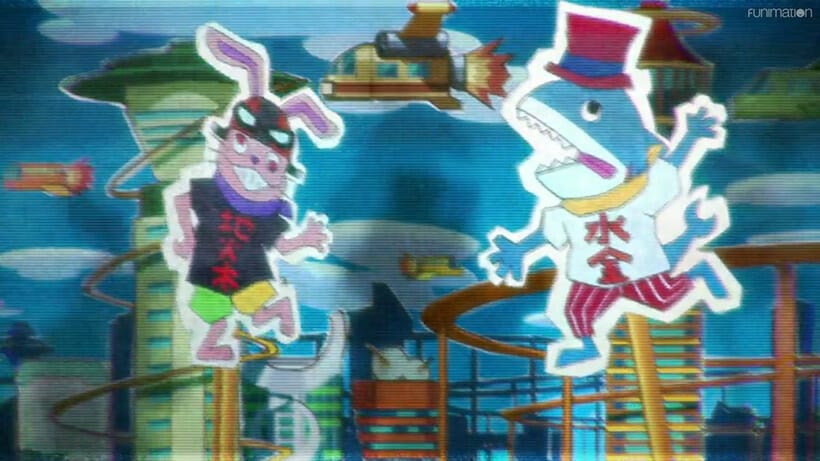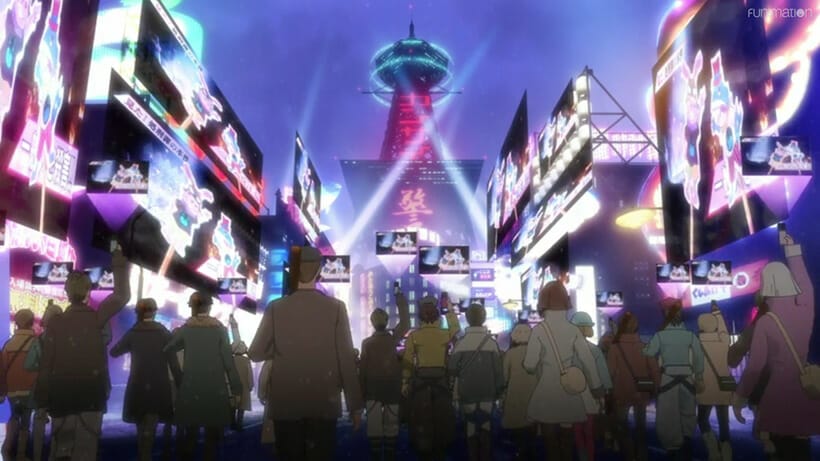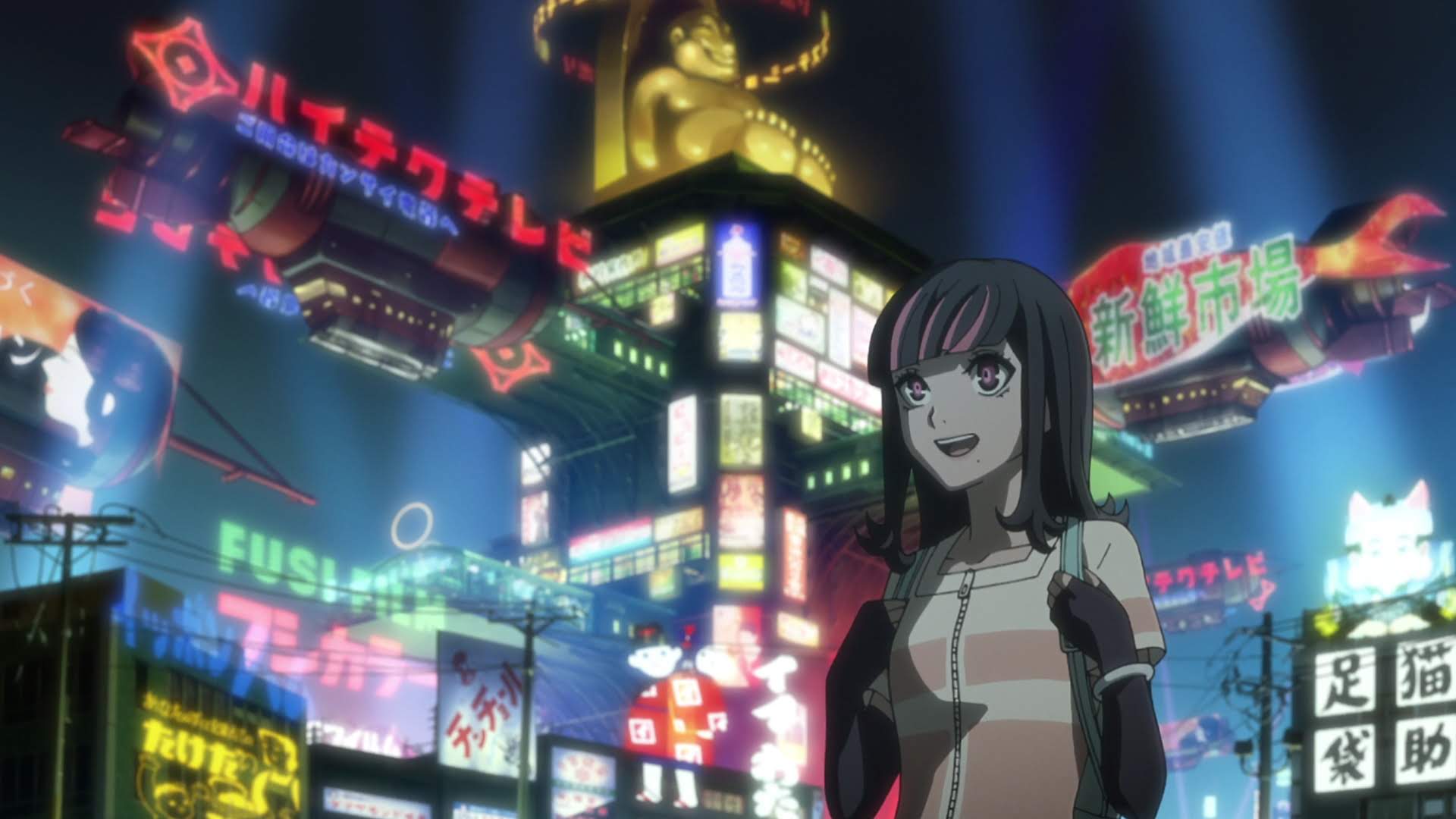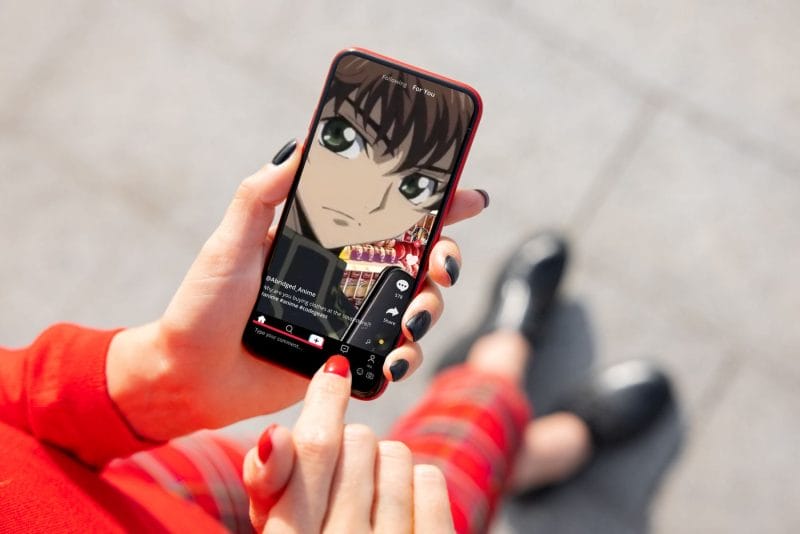Akudama Drive made an immediate impression with anyone who checked out its premiere in Fall 2020. With its colorful cast of characters, a clearly Blade Runner-inspired setting, and seemingly non-stop action from the jump, it was hard to look away. If one were to ask anyone to describe what had actually happened in the episode, or in a more broad sense what the show was about, though, they’d probably have been met by shrugs. Truth be told, this didn’t matter—Akudama Drive had successfully captured an audience interested in seeing where all of its bombast would lead.
What came after was indeed worth the wait, as Akudama Drive juggles a lot of ideas. Class struggles, propaganda, a timely takedown of punitive justice, all of these concepts and more, and despite its mad dash to the finish line, it manages to stick the landing on all of them. What goes underappreciated, though, is the way the show’s aesthetic choices enhance its strong writing, reflecting its themes.

It’s not actually that surprising – Akudama Drive is anything but subtle. The title frequently, gleefully indulges itself in its obvious inspirations, from Quentin Tarantino to Stanley Kubrick, in ways that might not seem immediately relevant to what the narrative is actually trying to convey. It overwhelms the senses, and a viewer could be forgiven for mentally checking out somewhere between the lightsaber batons and the railgun motorcycle.
Still, it is impossible to deny that all of that excess, from the gratuitous violence to the bitrate-destroying hacking sequences, is part of the text, rather than an addition to it. Indeed, Akudama Drive’s themes seep into every aesthetic choice, which are given as equally strong a consideration as the writing.
The style is the substance.
This is immediately apparent in the series’ character designs, which do not fail to grab the attention of newcomers. Much like his work in Danganronpa, Komatsuzaki delivers a style that, despite first impressions, quickly answers the question of “how do we tell you who this is as quickly as possible?” For example, Doctor’s white coat, skin-tight dress, and heels immediately tell the viewer that she’s there to patch things up with no regard to ethics. Likewise, Hoodlum’s pompadour and cheap suit proudly proclaim that he’s a punk putting on airs. With only twelve episodes and plenty of plot to get through, any sort of narrative economy that can be spared should be, and these designs work well to serve that exact purpose.
These designs also work thematically in the oppressive world of Akudama Drive, standing out is itself an act of rebellion. Even Swindler, who starts the series as a supposedly “normal” person,, has her iconic pink highlights to hint toward her potential. As such, the Akudama stand in stark contrast to the Executioners, who all clad in the same white suit, and are trained to fall in line for the sake of the state.
This comparison can also be seen within Akudama Drive’s environments, which are uniform and gray, with splashes of gaudy neon that barely even attempt to liven up the cityscape. Against the lifelessness of the world around them, the garish designs of the Akudama provide a feeling of something human peeking through, showing the audience that, even in a society designed to be soulless, the power of human expression can shine.
Moreover, while the concrete and neon obviously borrow heavy inspiration from cyberpunk, they also serve more subtle purposes toward the overall world-building. In Akudama Drive, the further one goes from Kansai, the more decrepit and worn the surroundings become. Notably, “far from Kansai” in the story means “closer to Kanto,” the location of the old war that is constantly referenced and the true origin of the story. But despite that destruction and painful history, what the gang finds upon arriving in Kanto for the first time are the remnants of an old technology exhibition, filled with dreams of a bright future. The exhibition’s overall aesthetic is a throwback to a simpler vision of the future, more like Tomorrowland or the Jetsons, providing a stark contrast to the cyberpunk dystopia found within the rest of the series. Sadly, that colorful vision is hidden away from the people of Akudama Drive’s Japan, their imaginations limited by their own governance to the grays of their cities and the propaganda they allow for education.

This all builds up to what is arguably the most extravagant part of Akudama Drive: its violence. The glorious, bloody, sometimes exciting and sometimes excruciatingly sad brutality It’s far from a new idea to depict characters, especially those of repressed and oppressed groups, to violence, and this is a trope that the series uses to great effect.The Executioners use violence as a means of control, exerting their power over others in a way not unlike real-world law enforcement. The Akudama, in return, use violence to defend their autonomy.
One step above both of those, though, is Boss, who reveals to Pupil halfway through the series that Executioners are deployed in pairs in order to emotionally tie them to their work—to keep them fighting in order to protect their own. In other words, while Boss uses the threat of violence as a tool of control against Akudama in the form of Executioners, she exerts this same coercive power against the Executioners, themselves. In this light, while the Executioners are the enemy of the Akudama, they are, in their own way, oppressed by the greater system’s less obvious but equally destructive forms of violence. It’s in this light that Master and Brawler come close to finding solidarity with one another in their final moments, as the former comes to realize that he had much in common with the latter.
In the context of the Pupil’s arc, though, Akudama Drive holds little faith in the idea that those who are indoctrinated into such a brand of effective fascism can ever truly turn their backs to it.

It’s within this context, after Akudama Drive used its twelve episodes to condition its audience to the show’s unique brand of over-the-top violence, that it pulls off its greatest trick. Over the course of the series, it becomes completely normal to see the Akudama and the Executioners engage in bloody combat. At the eleventh hour, though, during the climax, Akudama Drive extends that violence to the greater populace.
No matter how much Swindler, Courier, and the Siblings try, no matter how powerful the Akudama are, it is simply too much to expect them to fight the entire system of oppression alone.
Swindler’s death becomes a catalyst for the entire Kansai population to take control, their protest growing into the large, undeniable movement that succeeds the small rebellion of the Akudama. In this, more than anywhere else in the show, violence is a tool of liberation, a symbol of what is possible to achieve with cohesion and unity.
Upon a close look, Akudama Drive’s message becomes painfully clear: systems are large, and seemingly omnipotent, but nothing can stand against collective human will. It’s a message that echoes through all the flash and style of the show, from the designs, to the world, to the action, all of the choices made in Akudama Drive’s presentation point toward that same ultimate truth. While there is plenty to be found in the dialogue, character arcs, and plot twists, the series’ soul can be found in how it presents itself.
In the truest sense, Akudama Drive‘s style is its substance.












